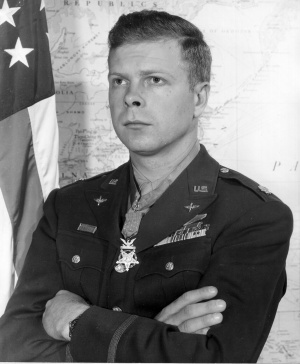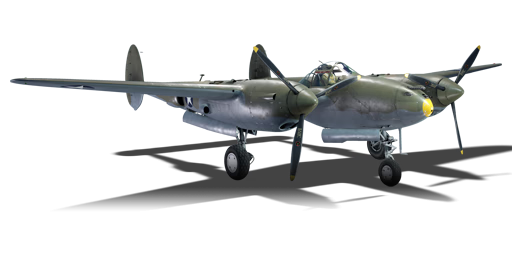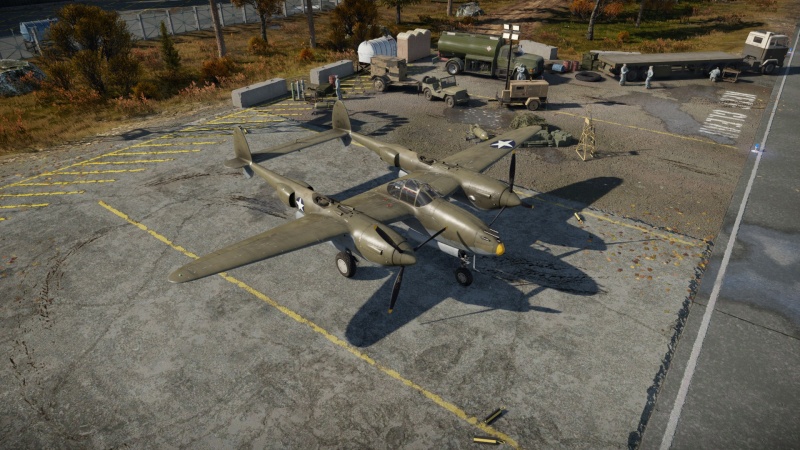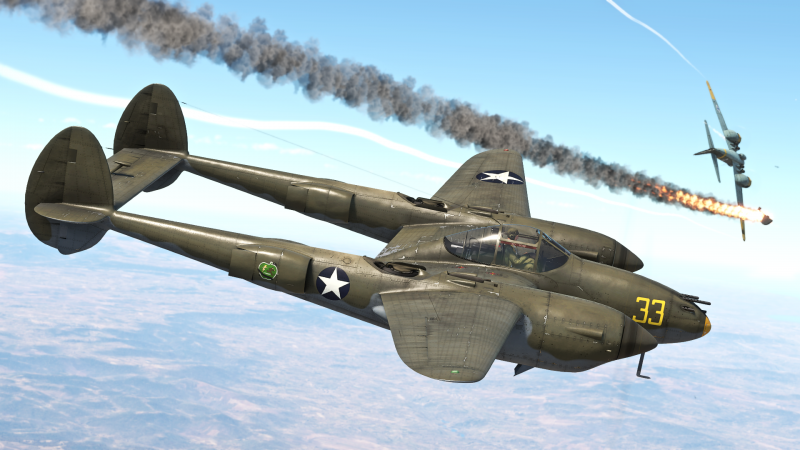P-38E
| This page is about the American twin-engine fighter P-38E. For other variants, see P-38 (Family). |
Contents
Description
The P-38E Lightning is a rank II American twin-engine fighter with a battle rating of 2.7 (AB), 3.0 (RB), and 3.3 (SB). It was introduced in Update 1.53 "Firestorm".
The P-38E is the first of the P-38 vehicles available in-game and is a very good plane. It gets an interceptor airspawn on most maps, which allows the P-38 to very often find itself above or at an equal altitude to its opponents. The main strength of the P-38E is its speed and energy retention, so it should be used accordingly - play it as an energy fighter or Boom 'n' Zoomer. The P-38E is also surprisingly manoeuvrable for such a large plane - while it can't outmanoeuvre single-engine fighters, it can put up a good fight.
General info
Flight performance
| Characteristics | Max Speed (km/h at 7,012 m) |
Max altitude (metres) |
Turn time (seconds) |
Rate of climb (metres/second) |
Take-off run (metres) | |||
|---|---|---|---|---|---|---|---|---|
| AB | RB | AB | RB | AB | RB | |||
| Stock | 612 | 594 | 12192 | 24.1 | 25.0 | 10.5 | 10.5 | 380 |
| Upgraded | 662 | 635 | 21.9 | 23.0 | 17.2 | 13.5 | ||
Details
| Features | ||||
|---|---|---|---|---|
| Combat flaps | Take-off flaps | Landing flaps | Air brakes | Arrestor gear |
| ✓ | ✓ | ✓ | X | X |
| Limits | ||||||
|---|---|---|---|---|---|---|
| Wings (km/h) | Gear (km/h) | Flaps (km/h) | Max Static G | |||
| Combat | Take-off | Landing | + | - | ||
| 790 | 289 | 565 | 495 | 250 | ~9 | ~5 |
| Optimal velocities (km/h) | |||
|---|---|---|---|
| Ailerons | Rudder | Elevators | Radiator |
| < 380 | < 460 | < 500 | > 420 |
| Compressor (RB/SB) | ||
|---|---|---|
| Setting 1 | ||
| Optimal altitude | 100% Engine power | WEP Engine power |
| 6,800 m | 1,050 hp | 1,176 hp |
Survivability and armour
- 7 mm steel - in front of cockpit
- 7 mm steel - pilot seat
- 10 mm steel behind pilot head
- 38 mm bulletproof glass - behind windscreen
Modifications and economy
Armaments
Offensive armament
The P-38E is armed with:
- 1 x 20 mm AN/M2 cannon, nose-mounted (150 rpg)
- 4 x 12.7 mm M2 Browning machine guns, nose-mounted (500 rpg = 2,000 total)
Usage in battles
Air Realistic Battles
While fast at its BR, the P-38 is slower than most planes it will face at 3.7 and 4.0, more specifically the Fw 190 A-1 and the Bf 109 F-4 and F-4/trop, although it does have an airspawn, which can be used to have the advantage on these enemies. Attempt to pick out planes at its BR and/or planes that are slower than it, then target them.
When dealing with faster opponents, evade and use teammates. If the direction it is caught going in is opposite to the team's side of the map, a handy trick is rolling over and pulling 180 degrees until the plane comes out the other direction, a manoeuvre known as a split S. It gains speed (instead of a horizontal turn, which loses it) and exposes the plane to the minimum amount of enemy fire while doing so, which is important, as the P-38 is very broad in the wings and prone to catching fire due to the fuel tanks.
In terms of ammunition, Air Targets is preferential for the cannon and Universal for the MGs, if stealth is not used. There are other options, most notably Ground Targets for the cannon and Tracers or Ground Targets for the .50 cals, but the tracers on the .50 cals are weak, unlike the M20 API-T on the P-51s and P-47s, and ground pounding should be reserved for later parts of the game in case a bomber is climbing to space, as the plane is an interceptor and cannot carry suspended armaments.
Ammo conservation on the cannon is not very important; it has a low fire rate and does not jam easily once the 'New 20 mm Cannon' modification is unlocked; moreover, each shell has a high damage output, especially on stealth. The .50 cals can be sprayed indiscriminately.
As a bomber-hunter, the P-38E is superb. Its nose-mounted armaments allow it to sit a kilometer behind enemy bombers such as He 111s, outside of effective range of their guns but still able to hit hard with its 20 mm cannon.
Being given an airspawn is a useful advantage that allows you to either climb up to higher targets, or dive to the deck for ground targets. As an interceptor, your first targets are usually bombers and other heavy/less manoeuvrable aircraft. Your straight line speed can be used to keep up with targets, and your 20 mm and decent energy retention to destroy them. Your speed in a dive can also outrun any aircraft you may want to avoid.
Manual Engine Control
| MEC elements | ||||||
|---|---|---|---|---|---|---|
| Mixer | Pitch | Radiator | Supercharger | Turbocharger | ||
| Oil | Water | Type | ||||
| Controllable | Controllable Auto control available |
Controllable Not auto controlled |
Controllable Not auto controlled |
Separate | Not controllable 1 gear |
Not controllable |
Pros and cons
Pros:
- Nose-mounted armaments give great long-range accuracy: no need to worry about convergence
- 500 rpg on 4 x .50 cal MGs allow for sustained fire
- 20 mm cannon can destroy most planes effectively, even in just a few shots
- Above average speed on the deck
- Decent at head-ons in a tight spot, due to the 20 mm cannon and nose-mounted .50 cals
- Can always get home with one engine left
- Very good flaps (fowler flaps) can be used in dog fights
Cons:
- Very large airframe is easy to hit and burns quite easily
- Easy target when flying slow
- Subpar energy recovery after a dive or when turning
- Can't fight with one engine
- The tail is prone to snapping off when hit by cannon shells, even at long ranges
History
Construction of the P-38 (XP-38) began in 1938 with a radically new type of fighter aircraft. Tasked with a twin-engine high-altitude interceptor, Lockheed Corporation built this aircraft to intercept and attack hostile aircraft at high altitudes. While the P-38D variants began to roll out with armoured windshields and self-sealing fuel tanks, it wasn't until October 1941 that the first combat-ready P-38E variants became available. The significant difference between the D and E variants came down to improved electrical and hydraulic systems, enhanced cockpit instruments and rearrangement of the nose-mounted machine guns. Due to the machine gun mounting configuration in the P-38D, they tended to jam frequently; however, with the off-set machine guns in the P-38E, ammunition belts had a straight feed into the guns.
Sent to Western Europe at the beginning of the war, P-38s operated with mixed results. While flying as bomber escorts, P-38s were often required to maintain formation with the bombers and not attack an enemy unless fired upon them first. German fighters realised this and would fly in high and from behind and would shoot the fighters and bombers without much recourse, downing many P-38s in this fashion. US military planners realised this error and allowed P-38s to leave formations to attack enemy aircraft when spotted.
P-38s spent time in North Africa and Italy, flying throughout the Mediterranean Theater; however, it was not until the P-38s started flying in the Pacific that this aircraft shined. Japanese aircraft had an advantage over the P-38 in their ability to turn. Still, the P-38s had a speed advantage that allowed them to build up energy in a dive, make an attack and then zoom away to a safe distance where they could turn around and make another attack run. With the centre-mounted machine guns on the P-38, they could begin shooting at a farther distance than the Japanese aircraft with wing-mounted machine guns configured for a specific convergence zone. Many missions required the tasking of P-38s, where large distances were needed to cover that many other US fighters did not have the fuel capacity for that type of assignment.
Over 10,000 P-38s were built throughout the war, seeing several upgrades and modifications, including cooling systems, propellers, engines and rocket tubes. The P-38 proved to be a valuable interceptor aircraft shooting down more Japanese aircraft than any other fighter employed during the war.
Notable pilots

Media
- Skins
- Videos
See also
- Aircraft of comparable role, configuration and era
External links
- Official data sheet - more details about the performance
- AAF Manual 51-127-1 - Pilot Training Manual for the Lightning P-38
| Lockheed Corporation | |
|---|---|
| Fighters | XP-38G · P-38E · P-38G-1 · P-38J-15 · Bong's P-38J-15 · P-38K · P-38L-5-LO · YP-38 |
| Bombers | B-34 · PV-2D |
| Jet Fighters | F-80A-5 · F-80C-10 |
| F-104A · F-104C | |
| Export / License | A-29 · ▄Hudson Mk V |
| ␗P-38L-1 | |
| ␗F-104A · ▀F-104G · ␗F-104G · ▄F-104G · ▅F-104J · ▄F-104S | |
| See Also | SABCA · Mitsubishi Heavy Industries · Fiat Aviation |
| USA twin-engine fighters | |
|---|---|
| P-38 | XP-38G · P-38E · P-38G-1 · P-38J-15 · Bong's P-38J-15 · P-38L-5-LO · P-38K · YP-38 |
| P-61 | P-61A-11 · P-61C-1 |
| F7F | F7F-1 · F7F-3 |
| Other | XF5F · XP-50 · F-82E |






